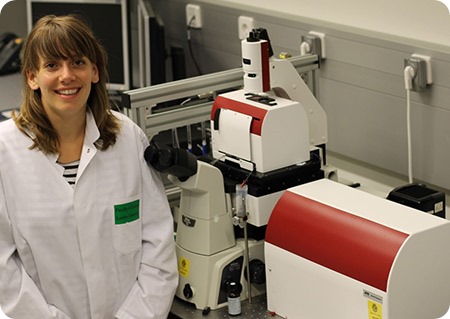Sep 9 2014
JPK Instruments, a world-leading manufacturer of nanoanalytic instrumentation for research in life sciences and soft matter, reports on the use of the NanoTracker™ Optical Tweezers system in the Laboratory of Molecular Genetics in the Leiden Institute of Chemistry at Leiden University.
Dr Rosalie Driessen is a post-doctoral researcher in the Laboratory of Molecular Genetics, a part of the Leiden Institute of Chemistry at Leiden University. She is studying the organization and dynamics of bacterial chromatin having received her doctorate from the University for her thesis entitled “The architects of crenarchaeal chromatin.”

Dr Rosalie Driessen with the JPK NanoTracker™ optical tweezers system located at the Leiden Institute of Chemistry
Dr Driessen describes her research and talks about the “hows and whys” of choosing to use optical tweezers in this work.
The research goal of our group is to understand how the genomic DNA is organised, in particular in bacterial and archaeal cells. Proteins that bind to the DNA (so-called nucleoid-associated proteins, chromatin proteins or architectural proteins) play an important role in dynamically shaping and compact the genome. These proteins are also referred to as architectural proteins as they shape the DNA by way of bridging, bending or wrapping the DNA. We want to understand how these proteins exactly function by understanding their DNA-binding properties and how they change the structure of DNA upon binding. In addition to conventional biochemical techniques, we conduct single-molecule experiments using techniques such as atomic force microscopy (AFM), tethered particle motion microscopy, magnetic tweezers and optical tweezers. Using optical tweezers (the JPK NanoTracker™) allows us to evaluate the physical properties of single DNA molecules (by pulling at single DNA molecules) and how this is affected by these specific proteins. We would like to use this in combination with fluorescent microscopy so we can actually visualise the proteins bound to the DNA and correlate this with the force response on the DNA molecule.
Dr Driessen works in the laboratory of Assistant Professor Remus Dame. Their on-going work is reported online.
The JPK NanoTracker™ is a very powerful system. For the first time, dual beam force-sensing optical tweezers have been seamlessly integrated on inverted optical microscopes combining advanced optical and confocal techniques including single molecule fluorescence in a small footprint, easy to use system. JPK’s unique tweezers technology (also known as a Photonic Force Microscope) enables quantification of molecular, cellular and micro-rheological processes. Applications include molecular motor mechanics, binding/elasticity of DNA and proteins, cell membrane dynamics and particle uptake.
For more details about JPK’s NanoTracker™ Optical Tweezers systems and their applications for the bio & nano sciences, please contact JPK on +49 30533112070, visit the web site: www.jpk.com or see more on Facebook: www.jpk.com/facebook and on You Tube: https://www.youtube.com/jpkinstruments.